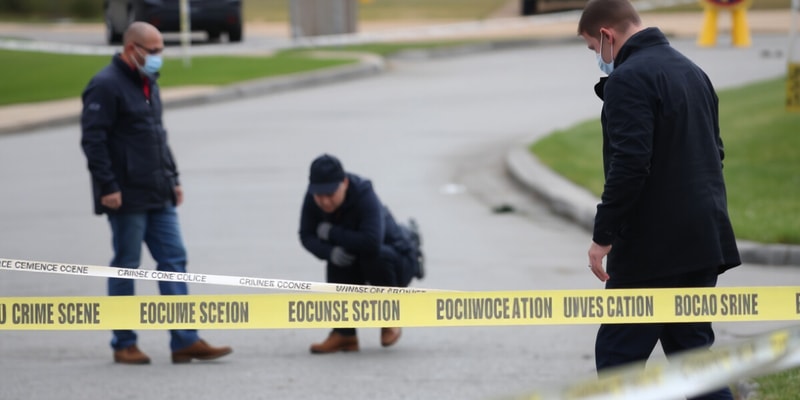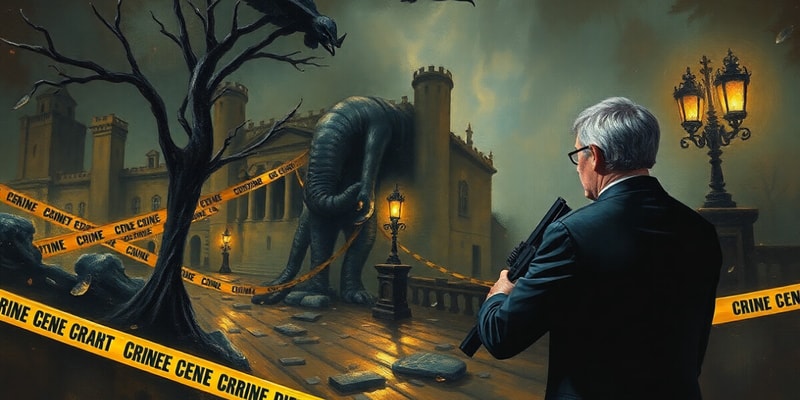Podcast
Questions and Answers
What is the first priority when responding to a crime scene?
What is the first priority when responding to a crime scene?
Why is it important to separate witnesses at a crime scene?
Why is it important to separate witnesses at a crime scene?
What is the purpose of scanning the crime scene initially?
What is the purpose of scanning the crime scene initially?
What type of documentation is created when individuals enter the crime scene?
What type of documentation is created when individuals enter the crime scene?
Signup and view all the answers
Who is responsible for photographing the evidence at a crime scene?
Who is responsible for photographing the evidence at a crime scene?
Signup and view all the answers
Which step follows the photographing of the crime scene evidence?
Which step follows the photographing of the crime scene evidence?
Signup and view all the answers
What does the sketch of a crime scene need to align with?
What does the sketch of a crime scene need to align with?
Signup and view all the answers
During the searching of the crime scene, what should investigators focus on?
During the searching of the crime scene, what should investigators focus on?
Signup and view all the answers
What is the primary purpose of evidence in a criminal case?
What is the primary purpose of evidence in a criminal case?
Signup and view all the answers
Which professional is not typically present at a crime scene?
Which professional is not typically present at a crime scene?
Signup and view all the answers
What is the first step in the crime scene investigation process?
What is the first step in the crime scene investigation process?
Signup and view all the answers
What is the primary function of the 'chain of custody' in forensic investigation?
What is the primary function of the 'chain of custody' in forensic investigation?
Signup and view all the answers
In the context of crime scene investigation, what does 'scanning the scene' involve?
In the context of crime scene investigation, what does 'scanning the scene' involve?
Signup and view all the answers
Which step follows 'searching the scene' in the crime scene investigation process?
Which step follows 'searching the scene' in the crime scene investigation process?
Signup and view all the answers
Which of the following is an example of a role played by specialists in a crime scene investigation?
Which of the following is an example of a role played by specialists in a crime scene investigation?
Signup and view all the answers
What is most critical for investigators to ensure during evidence collection?
What is most critical for investigators to ensure during evidence collection?
Signup and view all the answers
What is essential to maintain when handling physical evidence?
What is essential to maintain when handling physical evidence?
Signup and view all the answers
What is the purpose of using disposable gloves during evidence handling?
What is the purpose of using disposable gloves during evidence handling?
Signup and view all the answers
How should evidence be documented before it is moved?
How should evidence be documented before it is moved?
Signup and view all the answers
Which of the following is NOT a part of the chain of custody process?
Which of the following is NOT a part of the chain of custody process?
Signup and view all the answers
What happens if the evidence tape seal is broken?
What happens if the evidence tape seal is broken?
Signup and view all the answers
What should be used to secure very small pieces of evidence?
What should be used to secure very small pieces of evidence?
Signup and view all the answers
Which statement about the collection of evidence is FALSE?
Which statement about the collection of evidence is FALSE?
Signup and view all the answers
What must accompany evidence when it is transferred to a crime lab?
What must accompany evidence when it is transferred to a crime lab?
Signup and view all the answers
Study Notes
Securing the Crime Scene
- The first officer arriving at a crime scene must secure the area, but priority should be given to medical assistance and arresting the perpetrator.
- Once everyone is safe, unauthorized individuals should be excluded from the scene using barriers and guards.
- Every person entering the scene must be documented in crime scene logs, along with the time and date of entry and exit.
Separating Witnesses
- Witnesses must be separated to prevent them from influencing each other's accounts.
- Investigators will compare the separate accounts of witnesses.
- Witnesses are typically asked about their observations, location when making the observations, if they saw anyone else, and if they have any relevant information.
Scanning the Scene
- Investigators conduct a quick scan of the scene and mark evidence with markers.
- This allows for quick and efficient documentation of marked evidence.
- A more thorough search will be conducted later.
Seeing the Scene
- A trained forensic photographer takes photographs of the marked evidence.
- Photographs are taken for each new piece of evidence.
Sketching the Scene
- After photographs are taken, a crime scene investigator sketches the scene.
- The sketch shows the dimensions and location of all evidence.
- The sketch should accurately match the photographs and evidence markers.
Searching the Scene
- Investigators conduct a detailed search of the scene to find all evidence.
- A specific search pattern is used to ensure that the entire scene is covered.
- Any new evidence found is marked, photographed, and included in the sketch.
Securing and Collecting Evidence
- All evidence, regardless of size, must be preserved in its original state as much as possible.
- Each item is handled carefully and packaged separately to prevent cross-contamination.
- The search for evidence can extend beyond the crime scene (e.g., an autopsy may reveal evidence).
Securing and Collecting Evidence Continued
- Investigators should handle evidence in a way that prevents changes from the crime scene to the lab.
- Disposable gloves are crucial when handling evidence.
- Evidence should remain undisturbed until it's documented in notes, sketches, and photographs.
Chain of Custody
- The chain of custody protects evidence from the crime scene to the lab.
- Evidence should be packaged appropriately, sealed with evidence tape, and signed by the collecting officer.
- The seal should never be broken; if evidence must be processed, it should be removed without puncturing the signed label.
- A chain of custody log should be filled out and reflect everyone who handled the evidence.
Bindle for Small Evidence
- A bindle, sometimes called a druggist's fold, is used to secure very small pieces of evidence.
- The bindle ensures that evidence is not lost.
Studying That Suits You
Use AI to generate personalized quizzes and flashcards to suit your learning preferences.
Related Documents
Description
This quiz covers fundamental concepts in crime scene investigation, including securing the scene, separating witnesses, and initial scanning procedures. Test your knowledge of the protocols and best practices followed by investigators to ensure accurate and reliable information is gathered at the crime scene.




